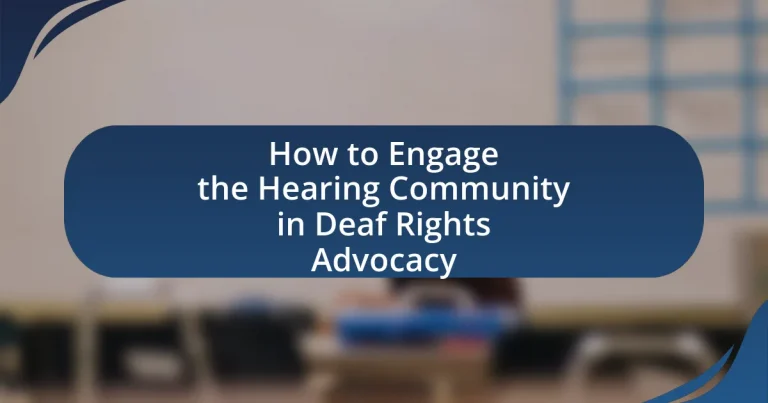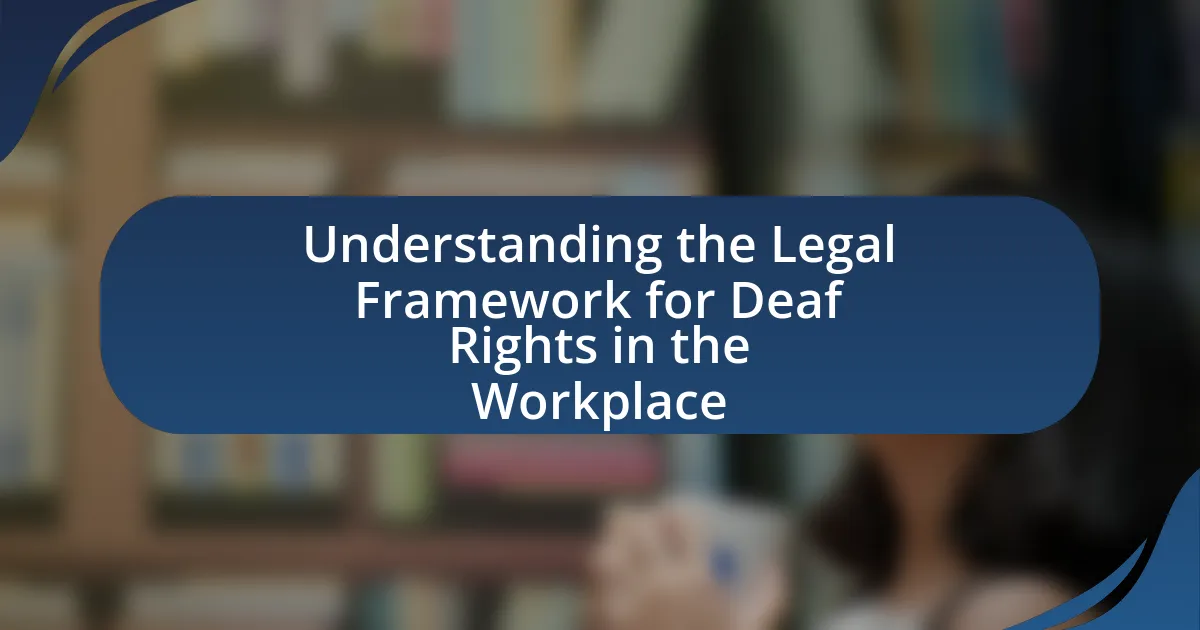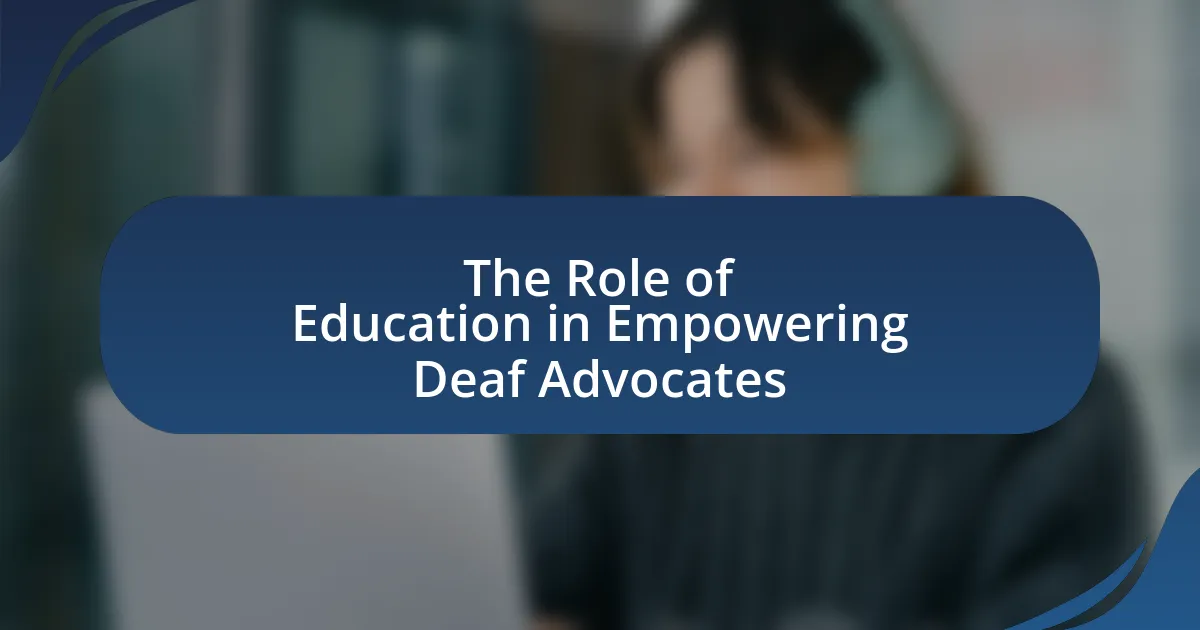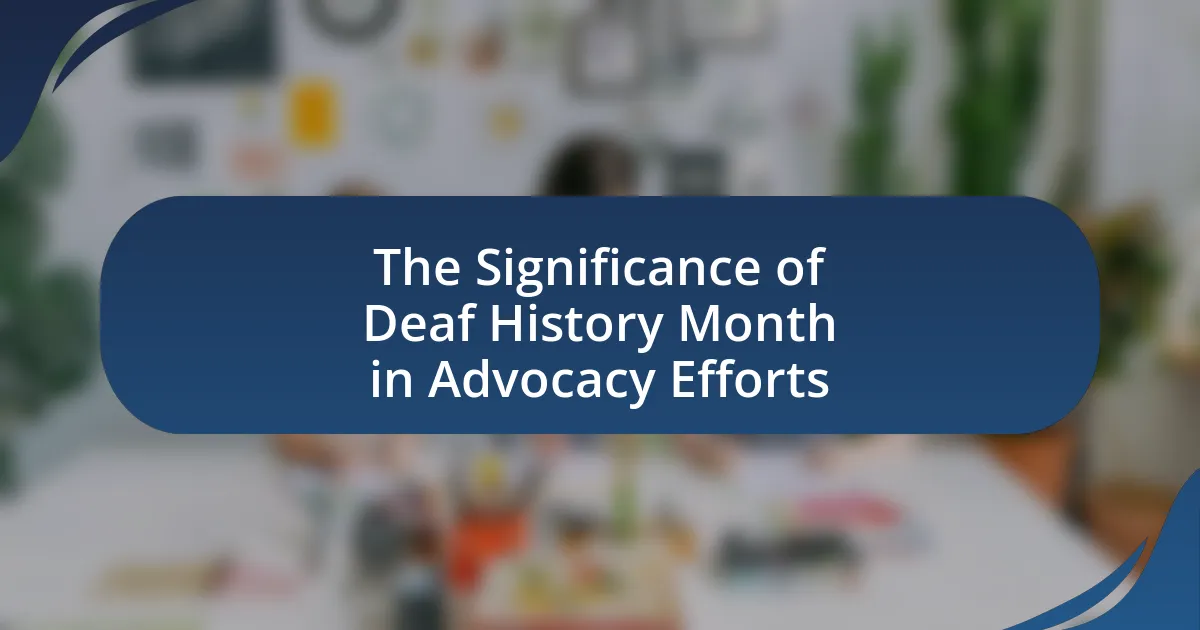The article focuses on the critical role of the hearing community in advocating for deaf rights. It outlines how hearing allies can amplify the voices of deaf individuals, challenge misconceptions, and promote inclusive policies that enhance accessibility. Key topics include the historical context of deaf rights advocacy, the challenges faced by the deaf community, and effective strategies for engagement, such as educational programs and community events. The article emphasizes the importance of collaboration between hearing and deaf individuals to foster understanding and drive meaningful change in societal perceptions and policies affecting the deaf community.
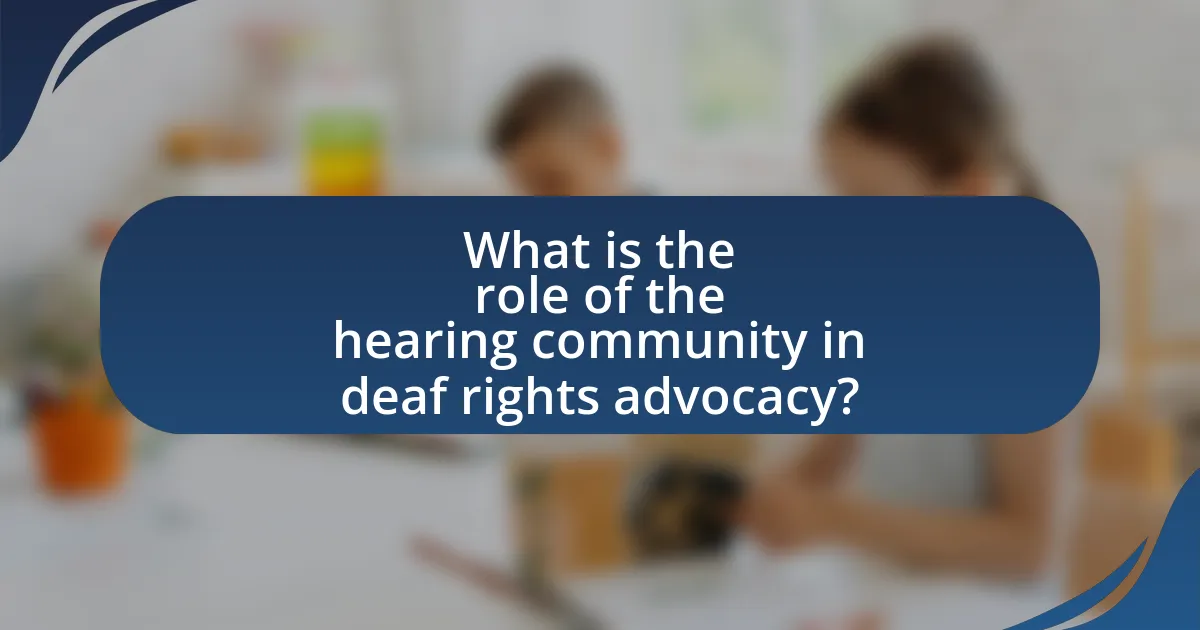
What is the role of the hearing community in deaf rights advocacy?
The hearing community plays a crucial role in deaf rights advocacy by amplifying the voices of deaf individuals and promoting awareness of their rights. Hearing advocates can leverage their societal influence to challenge misconceptions about deafness, support inclusive policies, and foster environments that prioritize accessibility. For instance, research indicates that when hearing allies participate in advocacy efforts, such as campaigns for sign language recognition or improved access to education, the impact is significantly greater, as seen in the successful passage of legislation like the Americans with Disabilities Act. This collaboration not only enhances visibility for deaf issues but also encourages a more inclusive society that values diversity and equal rights.
Why is it important for the hearing community to engage in deaf rights advocacy?
It is important for the hearing community to engage in deaf rights advocacy because their involvement fosters inclusivity and equality for deaf individuals. By participating in advocacy efforts, hearing individuals can help dismantle systemic barriers that limit access to education, employment, and social services for the deaf community. Research indicates that inclusive policies and practices lead to better outcomes for all, as seen in studies showing that diverse environments enhance creativity and problem-solving. Furthermore, the hearing community’s support amplifies the voices of deaf individuals, ensuring that their rights and needs are recognized and addressed in societal frameworks.
What historical context supports the need for hearing community involvement?
The historical context supporting the need for hearing community involvement in Deaf rights advocacy is rooted in the civil rights movements of the 1960s and 1970s, which emphasized the importance of allyship and social justice. During this period, marginalized groups, including the Deaf community, sought recognition and equal rights, leading to significant events such as the 1988 Deaf President Now protest at Gallaudet University, which highlighted the necessity for hearing allies to advocate for systemic change. This involvement is crucial as it fosters understanding, promotes inclusivity, and amplifies the voices of Deaf individuals, ensuring that their rights and needs are addressed in broader societal discussions.
How does the hearing community’s engagement impact deaf rights?
The engagement of the hearing community significantly enhances deaf rights by fostering awareness, understanding, and advocacy for equitable policies. When hearing individuals participate in discussions and initiatives related to deaf rights, they help to amplify the voices of the deaf community, leading to increased visibility of their needs and challenges. For instance, collaborative efforts between hearing allies and deaf activists have historically resulted in legislative changes, such as the Americans with Disabilities Act of 1990, which was influenced by advocacy from both communities. This engagement not only promotes inclusivity but also encourages the hearing community to challenge societal misconceptions about deafness, ultimately contributing to a more supportive environment for deaf individuals.
What are the challenges faced by the deaf community that require hearing allies?
The deaf community faces challenges such as communication barriers, social isolation, and limited access to services that require hearing allies for support. Communication barriers arise from the lack of understanding and use of sign language among hearing individuals, which can hinder effective interaction. Social isolation is prevalent due to the inability of many hearing people to engage with deaf individuals, leading to feelings of exclusion. Limited access to services, including healthcare and education, often occurs because many providers do not accommodate the needs of deaf individuals, such as providing interpreters. Hearing allies can advocate for better accessibility, promote awareness of deaf culture, and facilitate communication, thereby addressing these challenges effectively.
How do societal perceptions affect the deaf community’s rights?
Societal perceptions significantly impact the rights of the deaf community by shaping public attitudes, policies, and access to resources. Negative perceptions often lead to discrimination, limiting opportunities for education, employment, and social inclusion for deaf individuals. For instance, a study by the National Association of the Deaf found that misconceptions about deafness can result in inadequate support services, which directly affects the legal rights of deaf individuals to access communication and education. Furthermore, societal attitudes influence legislation; when the public views deafness as a disability rather than a cultural identity, it can hinder the recognition of sign language as a legitimate means of communication, thereby affecting the rights of the deaf community to use their language in legal and educational settings.
What barriers exist that hinder effective advocacy for deaf rights?
Barriers that hinder effective advocacy for deaf rights include societal misconceptions, lack of awareness, and insufficient representation in decision-making processes. Societal misconceptions often lead to stereotypes about deaf individuals, which can diminish their perceived capabilities and needs. Lack of awareness among the hearing community results in inadequate support and understanding of deaf rights issues, making it difficult to mobilize allies for advocacy efforts. Additionally, insufficient representation of deaf individuals in political and social spheres limits their ability to influence policies that affect their rights, as evidenced by the underrepresentation of deaf voices in legislative discussions and advocacy organizations.
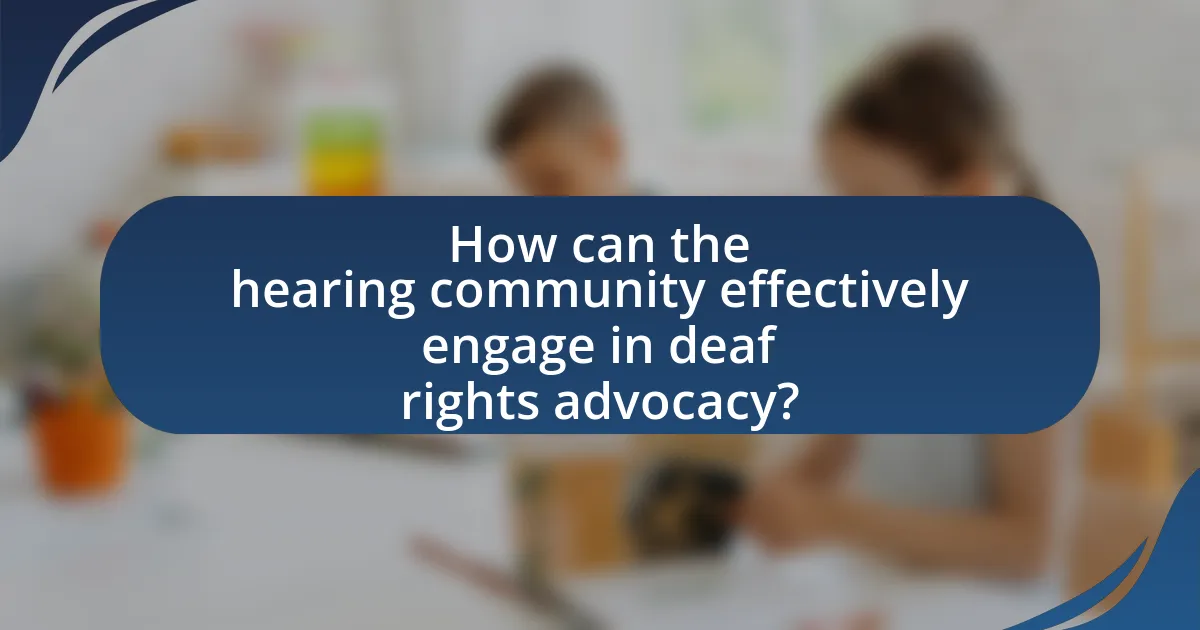
How can the hearing community effectively engage in deaf rights advocacy?
The hearing community can effectively engage in deaf rights advocacy by actively educating themselves about deaf culture and the challenges faced by deaf individuals. This engagement can include attending workshops, participating in deaf events, and collaborating with deaf organizations to amplify their voices. Research indicates that increased awareness and understanding lead to more effective advocacy efforts, as seen in initiatives like the National Association of the Deaf’s campaigns, which have successfully raised awareness about accessibility issues. By fostering relationships with deaf individuals and communities, the hearing community can create a more inclusive environment that supports deaf rights.
What strategies can be employed to raise awareness among the hearing community?
To raise awareness among the hearing community, strategies such as educational workshops, social media campaigns, and community events can be employed. Educational workshops can provide firsthand experiences and insights into the challenges faced by the deaf community, fostering empathy and understanding. Social media campaigns can leverage platforms like Instagram and Twitter to share stories, statistics, and resources, reaching a broader audience quickly. Community events, such as deaf awareness days or inclusive performances, can create opportunities for direct interaction and engagement, allowing hearing individuals to experience deaf culture and communication methods. These strategies have been shown to effectively increase awareness and promote advocacy for deaf rights.
How can social media be utilized to promote deaf rights advocacy?
Social media can be utilized to promote deaf rights advocacy by creating awareness, fostering community engagement, and amplifying deaf voices. Platforms like Twitter, Facebook, and Instagram allow advocates to share personal stories, educational content, and resources that highlight the challenges faced by the deaf community. For instance, campaigns such as #DeafAwarenessMonth leverage hashtags to reach wider audiences, increasing visibility and understanding of deaf rights issues. Research indicates that social media campaigns can significantly influence public perception and policy change, as seen in the advocacy efforts surrounding the Americans with Disabilities Act, which gained traction through online platforms.
What role do educational programs play in fostering understanding?
Educational programs play a crucial role in fostering understanding by providing knowledge and awareness about the experiences and rights of the Deaf community. These programs educate participants on the cultural, social, and linguistic aspects of Deafness, which helps to dismantle stereotypes and misconceptions. For instance, research by the National Association of the Deaf indicates that increased exposure to Deaf culture through educational initiatives leads to greater empathy and support for Deaf rights among hearing individuals. By facilitating dialogue and interaction between hearing and Deaf individuals, educational programs create a platform for shared experiences, ultimately promoting inclusivity and advocacy for Deaf rights.
How can partnerships between hearing and deaf individuals be formed?
Partnerships between hearing and deaf individuals can be formed through mutual understanding and effective communication strategies. Establishing common ground involves creating opportunities for interaction, such as workshops or community events that promote awareness of deaf culture and sign language. Research indicates that programs fostering collaboration between hearing and deaf individuals lead to increased empathy and support for deaf rights, as seen in initiatives like the “Deaf-Hearing Partnership Program” by the National Association of the Deaf, which emphasizes shared experiences and learning.
What are the best practices for creating inclusive advocacy groups?
The best practices for creating inclusive advocacy groups include actively involving diverse voices, ensuring accessibility, and fostering a culture of respect and collaboration. Actively involving diverse voices means recruiting members from various backgrounds, including those directly affected by the issues at hand, which enhances representation and understanding. Ensuring accessibility involves providing materials in multiple formats and accommodating different communication needs, thereby allowing all members to participate fully. Fostering a culture of respect and collaboration encourages open dialogue and mutual support, which is essential for effective advocacy. Research indicates that inclusive groups are more effective in achieving their goals, as they leverage a wider range of perspectives and experiences.
How can shared experiences enhance collaboration in advocacy efforts?
Shared experiences enhance collaboration in advocacy efforts by fostering empathy and understanding among participants. When individuals share personal stories related to a cause, such as deaf rights, they create a common ground that encourages deeper connections and collective action. Research indicates that narratives can significantly influence attitudes and behaviors, as demonstrated in a study by the Stanford Social Innovation Review, which found that storytelling can increase engagement and support for social causes. This shared understanding leads to more effective communication, stronger alliances, and a unified approach to advocacy, ultimately driving more impactful outcomes.
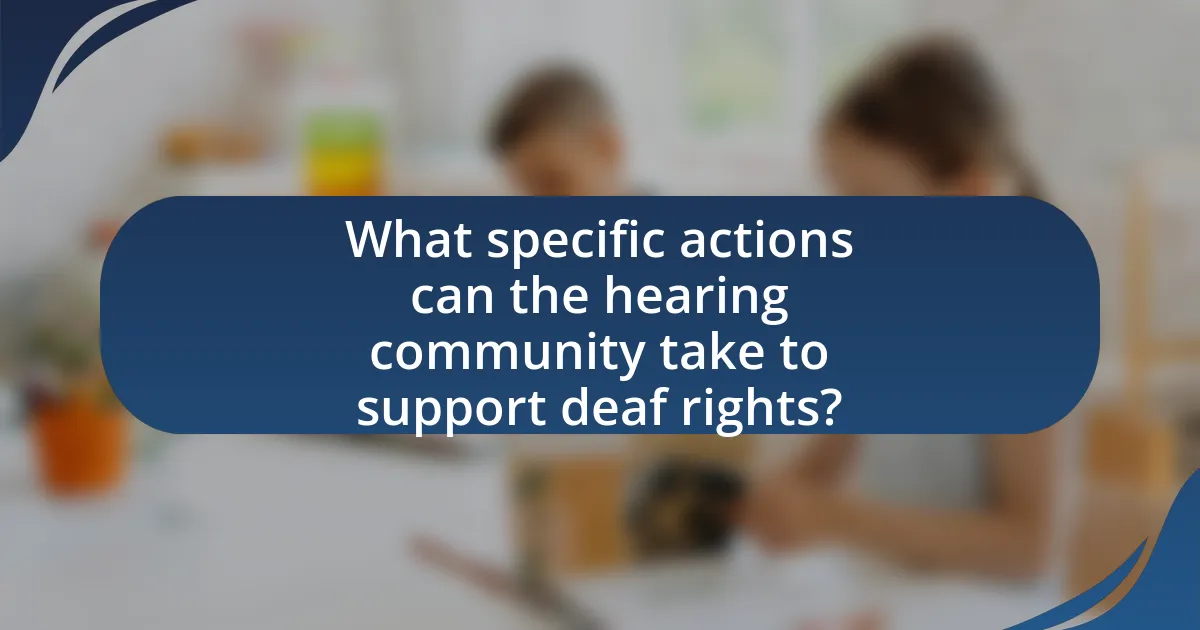
What specific actions can the hearing community take to support deaf rights?
The hearing community can support deaf rights by actively advocating for inclusive policies and practices. This includes promoting the use of sign language in public services, ensuring accessibility in educational settings, and supporting legislation that protects the rights of deaf individuals. For instance, the Americans with Disabilities Act mandates reasonable accommodations for individuals with disabilities, including those who are deaf, highlighting the legal framework that supports these actions. Additionally, hearing individuals can participate in awareness campaigns and engage in conversations that challenge stereotypes and misconceptions about deafness, fostering a more inclusive society.
How can individuals advocate for policy changes that benefit the deaf community?
Individuals can advocate for policy changes that benefit the deaf community by actively participating in awareness campaigns, engaging with policymakers, and collaborating with deaf advocacy organizations. Awareness campaigns can include organizing events that highlight the challenges faced by the deaf community, which can influence public opinion and encourage legislative support. Engaging with policymakers involves meeting with local representatives to discuss specific issues, such as access to education and employment opportunities for deaf individuals, thereby directly influencing policy decisions. Collaborating with established deaf advocacy organizations, such as the National Association of the Deaf, can provide individuals with resources and a platform to amplify their voices, ensuring that the needs of the deaf community are represented in policy discussions.
What are effective methods for lobbying local and national governments?
Effective methods for lobbying local and national governments include building coalitions, engaging in grassroots mobilization, and utilizing data-driven advocacy. Building coalitions with other organizations amplifies the voice of the advocacy group, as seen in successful campaigns like the Americans with Disabilities Act, which involved multiple stakeholders. Grassroots mobilization encourages community involvement, demonstrated by initiatives where local citizens contact their representatives, significantly increasing the likelihood of legislative support. Utilizing data-driven advocacy involves presenting compelling statistics and research to support policy changes, as evidenced by studies showing that informed advocacy efforts can lead to a 20% increase in legislative responsiveness.
How can community events promote deaf rights awareness?
Community events can promote deaf rights awareness by providing a platform for education and interaction between deaf individuals and the hearing community. These events often include workshops, presentations, and demonstrations that highlight the challenges faced by deaf individuals, fostering understanding and empathy. For instance, events like Deaf Awareness Week or local deaf festivals can showcase deaf culture and sign language, encouraging participation from hearing individuals. Research indicates that increased exposure to deaf culture through community events leads to greater awareness and advocacy for deaf rights, as evidenced by studies showing that communities with active deaf events report higher levels of support for deaf rights initiatives.
What resources are available for the hearing community to learn about deaf rights?
The hearing community can access various resources to learn about deaf rights, including organizations, websites, and educational materials. Notable organizations such as the National Association of the Deaf (NAD) and the World Federation of the Deaf (WFD) provide comprehensive information on deaf rights, advocacy, and legal protections. Websites like the NAD’s official site offer resources, articles, and guides specifically aimed at educating the hearing public about the challenges faced by the deaf community. Additionally, educational materials such as books, documentaries, and online courses are available to further enhance understanding of deaf rights and promote advocacy efforts.
Which organizations provide support and information on deaf advocacy?
Organizations that provide support and information on deaf advocacy include the National Association of the Deaf (NAD), the American Deafness and Rehabilitation Association (ADARA), and the Hearing Loss Association of America (HLAA). The NAD focuses on civil rights and advocacy for deaf individuals, promoting equal access and opportunities. ADARA emphasizes rehabilitation and support services for deaf and hard-of-hearing individuals, while HLAA provides resources and advocacy for those with hearing loss. These organizations are instrumental in raising awareness and promoting the rights of the deaf community.
How can workshops and training sessions enhance advocacy skills?
Workshops and training sessions enhance advocacy skills by providing participants with practical knowledge, strategies, and tools necessary for effective communication and engagement. These structured learning environments facilitate skill development through interactive activities, role-playing, and expert-led discussions, which help individuals understand the nuances of advocacy in specific contexts, such as deaf rights. Research indicates that experiential learning, often employed in workshops, significantly improves retention and application of advocacy techniques, leading to more impactful advocacy efforts. For instance, a study published in the Journal of Advocacy and Social Change found that participants in advocacy training reported a 40% increase in confidence and effectiveness in their advocacy roles after completing a workshop series.
What are some practical tips for engaging in deaf rights advocacy?
To engage in deaf rights advocacy effectively, individuals should prioritize education and awareness-raising about deaf culture and rights. This can be achieved by organizing workshops and seminars that highlight the challenges faced by the deaf community, such as communication barriers and access to services. Research shows that informed communities are more likely to support inclusive policies; for instance, a study by the National Association of the Deaf indicates that awareness campaigns significantly increase public understanding of deaf issues. Additionally, collaborating with deaf organizations can amplify advocacy efforts, as these groups often have established networks and resources. Engaging in social media campaigns can also reach a broader audience, promoting deaf rights and encouraging allyship among hearing individuals.
